
Amrithaghateswarar Abhirami Temple (also called Abhirami temple is a Hindu temple dedicated to Shiva in his manifestation as Kalantaka and his wife Parvati as Abhirami. There is a Shrine for Maha Vishnu as Amrithanarayana and his consort Mahalakshmi as Amrithavalli. It is located in Thirukkadaiyur, 21 km East of Mayiladuthurai, Tamil Nadu in India. This temple is associated with the legend of Shiva saving his young devotee, Markendeya from death, and the tale of a saint, Abirami Pattar a devotee of the presiding goddess.

Tiruvalithayam Tiruvallesvarar Temple is a temple dedicated to the Hindu deity Shiva, located at Padi, a north-western neighbourhood of Chennai, India. Shiva is worshiped as Tiruvalleswarar, and is represented by the lingam and his consort Parvati is depicted as Jagadambiga. The presiding deity is revered in the 7th century Tamil Saiva canonical work, the Tevaram, written by Tamil poet saints known as the nayanars and classified as Paadal Petra Sthalam.
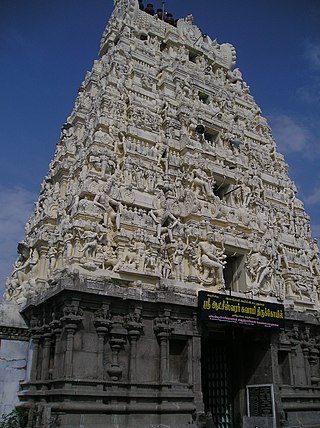
Aksheeswaraswamy Temple, Acharapakkam is a Hindu temple dedicated to Shiva located in Acharapakkam, Tamil Nadu, India. Shiva is worshiped as Aksheeswaraswamy or Atchikontantar, and is represented by the lingam and his consort Parvati is depicted as Sundaranayagi. The presiding deity is revered in the 7th century Tamil Saiva canonical work, the Tevaram, written by Tamil saint poets known as the nayanars and classified as Paadal Petra Sthalam. The temples has several inscriptions dated to the period of Kulothunga Chola I.
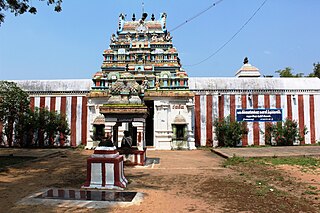
Vilwaneswarar temple is a Hindu temple dedicated to Shiva located in Thiruvaikavur, Tamil Nadu, India. The temple is located 8 km (5.0 mi) north of Kumbakonam, on the southern bank of Kollidam. Constructed in the Dravidian style of architecture, the temple is believed to have been built during the Cholas period in the 7th century. Shiva is worshipped as Vilwaneswarar and his consort Parvati as Valaikai Nayagi.
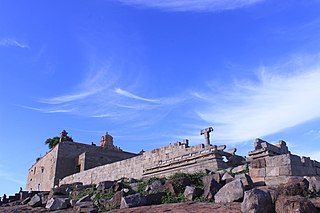
Erumbeeswarar Temple in Thiruverumbur, Tamil Nadu, India, is a Hindu temple dedicated to the deity Shiva. Built on a 60-foot (18 m) tall hill, it is accessible via a flight of steps. The temple's main shrines and its two prakarams are on top of the hill, while a hall and the temple tank are located at the foothills. Shiva is believed to have transformed himself into an ant hill and tilted his head at this place to enable ants to climb up and worship him. Erumbeeswarar is revered in the canonical 7th-century Tamil Saiva work the Tevaram, written by Tamil saint poets known as nayanmars and classified as Paadal Petra Sthalam.
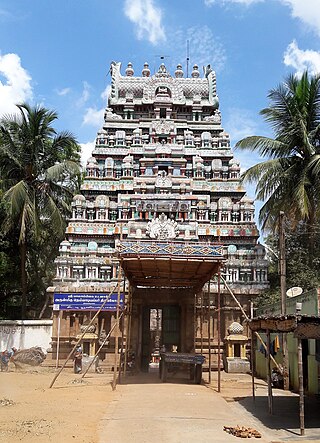
Neyyadiappar Temple, Tillaistanam is a Hindu temple dedicated to Shiva located in the village of Thillaisthanam also known as Tillaisthanam or Thiruneithanam in Tamil Nadu, India. It is significant to the Hindu sect of Shaivism as one of the Saptasthanam, the seven temples associated with Aiyarappar temple in Thiruvaiyaru. Shiva is represented by the lingam in the form of Neyyadiappar. His consort Parvati is depicted as Piraisoodi Amman. The presiding deity is revered in the 7th century Tamil Shaiva canonical work, the Tevaram, written by Tamil saint poets known as the nayanars and classified as Paadal Petra Sthalam.
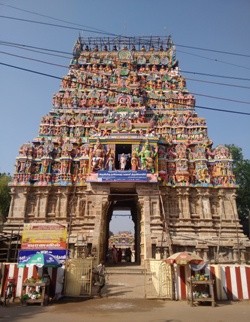
Nageswaraswamy Temple, Kumbakonam is a Hindu temple dedicated to Shiva located in Kumbakonam in Thanjavur district, Tamil Nadu, India. The presiding deity is revered in the 7th-century Tamil Saiva canonical work, the Tevaram, written by Tamil poet saints known as the nayanars and classified as Paadal Petra Sthalam. The temple is counted as the earliest of all Chola temples. Shiva in the guise of Nagaraja, the serpent king..
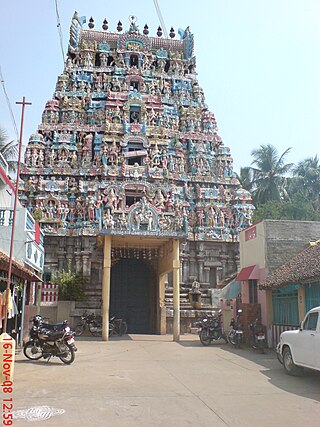
Kasi Viswanathar Temple, Kumbakonam is a Hindu temple dedicated to Lord Shiva, located in Kumbakonam, Tamil Nadu, India. Here, Lord Shiva is worshipped as Kasi Viswanathar, and His consort Parvati is depicted as Visalakshi. The presiding deity is revered in the 7th-century Tamil Saiva canonical work, the Tevaram, written by Tamil saint poets known as the nayanars and classified as Paadal Petra Sthalam.
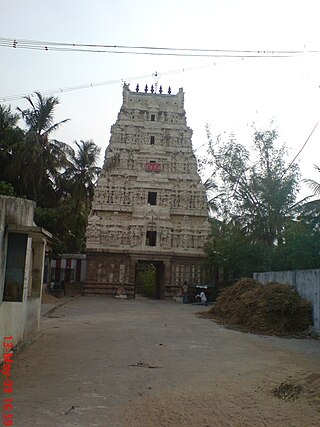
Anbil Alanthurai Temple is a temple dedicated to Shiva, located on the banks of the Kollidam river in Anbil, a small village near Lalgudi. is a Hindu temple dedicated to Shiva located in the village of Tiruchotruthurai, Tamil Nadu, India. Shiva is worshiped as Sathyavaheeswarar, and is represented by the lingam and his consort Parvati is depicted as Soundaranayagi. The presiding deity is revered in the 7th century Tamil Saiva canonical work, the Tevaram, written by Tamil poet saints known as the nayanars and classified as Paadal Petra Sthalam.

Maanturai Amravaneswarar Temple, is a temple dedicated to Hindu deity Shiva, located in Manturai, a village in the outskirts of Trichy, in the South Indian state of Tamil Nadu. It is one of the 275 Paadal Petra Sthalams, where the three of the most revered Nayanars, Appar and Tirugnana Sambandar have glorified the temple with their verses during the 7th-8th century. The temple has been widely expanded by Chola kings during the 11th century. The temple has three tiered gateway tower and a tank. Since Shiva bestowed a deer with a mango, this place is called Manthurai.

Sivayoginathar Temple also known as Yoganandeswarar temple is a Hindu temple dedicated to Shiva located in is located in Thiruvisanallur in Thanjavur district, Tamil Nadu, India. Shiva is worshiped as Sivayoginathar, and is represented by the lingam and his consort Parvati is depicted as Mangala Nayagi. The presiding deity is revered in the 7th century Tamil Saiva canonical work, the Tevaram, written by Tamil poet saints known as the nayanars and classified as Paadal Petra Sthalam.

Sivagurunathaswamy templeis a Hindu temple dedicated to Shiva located in the village of Aduthurai, Tamil Nadu, India. Shiva is worshipped as Sivagurunathaswamy, and is represented by the lingam. His consort Parvati is depicted as Prabhavalli. The presiding deity is revered in the 7th century Tamil Saiva canonical work, the Tevaram, written by Tamil saint poets known as the nayanars and classified as Paadal Petra Sthalam.
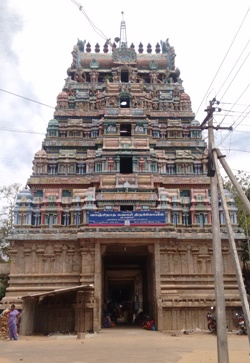
Vanchinadha Swamy temple is a Hindu temple dedicated to the deity Shiva, located in Srivanchiyam, Tiruvarur District, Tamil Nadu, India. Shiva is worshiped as Vanchinadha Swamy, and is represented by the lingam. His consort Parvati is depicted as Mangalambigai Amman. The presiding deity is revered in the 7th century Tamil Saiva canonical work, the Tevaram, written by Tamil saint poets known as the Nayanmars and classified as Paadal Petra Sthalam.

Prananadeswarar Temple is a Hindu temple dedicated to Shiva located in Thirumangalakudi in Mayiladuthurai district of Tamil Nadu, India. Shiva is worshiped as Prananatheswarar, and is represented by the lingam and his consort Parvati is depicted as Mangala Nayagi. The presiding deity is revered in the 7th century Tamil Saiva canonical work, the Tevaram, written by Tamil poet saints known as the nayanars and classified as Paadal Petra Sthalam.

Sakshinatheswarar Temple or Thiruppurambiyam Temple is a Hindu temple dedicated to the God Shiva located in Thiruppurambiyam, Tamil Nadu, India. Shiva is worshipped as Sakshinathar, and is represented here by a Lingam. His consort, Parvati, is depicted as Ikshuvani. The presiding deity is revered in the 7th century Tamil Saiva canonical work, Thevaram, written by Tamil saint poets, known as the Nayanmaars and classified as Paadal Petra Sthalam.

Vedapuriswarar Temple, Thiruvedhikudi or Vazhaimadunathar Temple is a Hindu temple dedicated to Shiva located in Thiruvedhikudi near Tiruvaiyaru, Tamil Nadu, India. The presiding deity is revered in the 7th century Tamil Saiva canonical work, the Tevaram, written by Tamil poet saints known as the nayanars and classified as Paadal Petra Sthalam. The temple is counted as the earliest of all Chola temples.
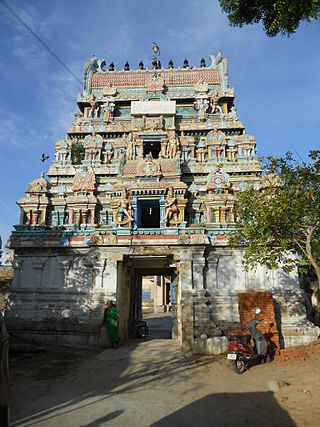
Padikasu Nathar Temple is a Hindu temple located at Azhagaputhur, a village in the Thanjavur district of Tamil Nadu, India. Shiva is worshiped as Padikasunathar, and is represented by the lingam. His consort Parvati is depicted as Soundaranayagi. The presiding deity is revered in the 7th century Tamil Saiva canonical work, the Tevaram, written by Tamil saint poets known as the nayanars and classified as Paadal Petra Sthalam. The 8th century Saiva saint poet Sundarar has sung praise about the temple in his works.
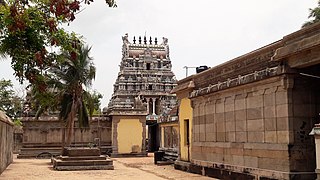
Agastheeswarar Temple is a Hindu temple dedicated to Shiva, located in the town of Agathiyampalli, Nagapattinam district in Tamil Nadu, India. The presiding deity is revered in the seventh century Tamil Saiva canonical work, the Tevaram, written by Tamil saint poets known as the nayanmars and classified as Paadal Petra Sthalam. The temple is locally called Agasthiyar Kovil.

Vaseeswarar Temple is a Hindu temple dedicated to the deity Shiva, located in Thirupasoor, a village in Tiruvallur district in the South Indian state of Tamil Nadu. Shiva is worshiped as Vaseeswarar, and is represented by the lingam. His consort Parvati is depicted as Pasupathinayagi. The temple is located on the Southern banks of Poondi reservoir on the Thiruvallur - Thiruthani road, 5 km (3.1 mi) away from the town. The presiding deity is revered in the 7th century Tamil Saiva canonical work, the Tevaram, written by Tamil saint poets known as the nayanmars and classified as Paadal Petra Sthalam.

Oondreswarar Temple is a Hindu temple dedicated to the deity Shiva, located in Poondi, a village in Tiruvallur district in the South Indian state of Tamil Nadu. Shiva is worshiped as Oondreswarar, and is represented by the lingam. His consort Parvati is depicted as Minnoli Amman. The temple is located on the Northern banks of Poondi reservoir on the Thiruvallur - Thiruthani road, 11 km (6.8 mi) away from the town. The presiding deity is revered in the 7th century Tamil Saiva canonical work, the Tevaram, written by Tamil saint poets known as the Nayanmars and classified as Paadal Petra Sthalam.

























